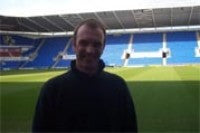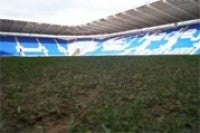Dual Sport at Reading
Dual Sport at Reading

The pitch at the Madejski Stadium hosted both rugby and football last season. It was felt that given the aspect of the new stadium and its wrap around structure, wasn't beneficial to playing two sports without some form of reinforcement.
Our last match at the end of last season was the Rugby European Shield on the 20th May. As soon as the game was over, the contractors set to work on the pitch, stripping off 100mm of the soil and carting it away. Once the top was off, 150 mm of Leighton buzzard sand was put on and graded to determined levels. The sand was then rotovated at 200mm to incorporate the soils underneath, producing a root zone medium. The levels were then graded again, the pitch consolidated and seeded. Basal fertilisers were applied.
The seed went on a month after work had commenced on the 20th June. The seed was perhaps two weeks old and not really established when August. It took until four days before this game for the pitch to be fully reinforced. This picture shows the 'Desso' close up in our goalmouth.
August. It took until four days before this game for the pitch to be fully reinforced. This picture shows the 'Desso' close up in our goalmouth.
While the machines continued working in July, I had worked hard trying to get the grass established to maturity, cutting (four times per week), fertilising (full rate 12:3:9 every three weeks) and watering the pitch with regularity.
Even so I felt that the grass still looked really young when the season kicked off.

Through the winter I have tried to keep the heavier machinery off the pitch, choosing instead to cut with Hayter rotaries. The rotaries have a small roller to help present the pitch without any real weight being applied to the surface. More recently I have used the Toro procore with
I haven't as yet used any heavier machines such as a vertidrain.
Nearly all our rugby matches have been played 'back to back' with the football which has meant many of our Saturday evenings have been spent turning a football pitch into a rugby pitch for the Sunday game.
Overall the pitch has performed very well this year considering that sport started on the new grass so early. For the first few weeks I found that there was a lot of movement in the top of the pitch. This movement stopped once the grass became more established and the roots had matured.
We have the benefit of under soil heating which is great in keeping the ground soft and able to take a stud, however the heating doesn't seem to clear the frost from the leaf very well and I witnessed a huge amount of grass loss after the New Year. When we have had very cold mornings and the players have been unable to train elsewhere, they have come on the pitch. There have been some very severe frosts and you could hear the 'crunch, crunch, crunch' as the players walked out on the pitch, bruising and breaking the grass.
My biggest wear area this season is in the centre circle and this is down to the rugby. During the game, there are probably about 12 scrums in this area. The scrum weighs around two tonnes so there is in excess of 24 tonnes mauling through the centre each game! The 'Desso' has 

I have been feeding the pitch at half rate using a 4:0:10 fertiliser every four weeks since the autumn. I have not used any other feeds, the PH is neutral, and so the root zone is at optimum level for grass growth and recovery. In the last week or so I have put some grass seed through the barer areas using a star seeder.
I hope now with the warmer weather, that the pitch will recover quite well to the end of the season. With a good sward of established grass now, I would hope that we can improve the pitch further next season.
